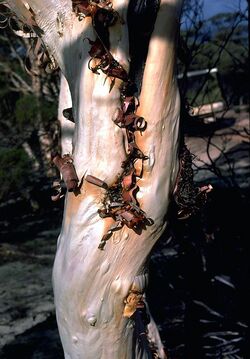Biology:Melaleuca exuvia
| Melaleuca exuvia | |
|---|---|

| |
| Melaleuca exuvia bark | |
| Scientific classification | |
| Kingdom: | Plantae |
| Clade: | Tracheophytes |
| Clade: | Angiosperms |
| Clade: | Eudicots |
| Clade: | Rosids |
| Order: | Myrtales |
| Family: | Myrtaceae |
| Genus: | Melaleuca |
| Species: | M. exuvia
|
| Binomial name | |
| Melaleuca exuvia Craven & Lepschi[1]
| |
Melaleuca exuvia is a plant in the myrtle family, Myrtaceae and is endemic to the south of Western Australia. It is easily distinguished by its unusual rough, minni ritchi bark which peels to reveal a new layer of smooth, salmon-pink bark. It is a newly described (2004) species which was formerly included in Melaleuca uncinata.
Description
Melaleuca exuvia is a large shrub growing to 6 m (20 ft) tall with rough, pinkish-grey bark which peels annually in a pattern known as minni ritchi to reveal new, smooth salmon-pink bark. It often has more than one stem and a crown up to 9 m (30 ft) across. Its leaves are erect, cylinder-shaped, linear to narrow elliptic and circular in cross-section, narrowing to a usually hooked end. They are 7–30 mm (0.3–1 in) long and 0.6–1.3 mm (0.02–0.05 in) in diameter.[2][3]
The flowers are white to yellow and arranged in heads containing 3 to 8 groups of flowers in threes. The petals are oval in shape, 1–1.4 mm (0.04–0.06 in) long and the stamens are arranged in five bundles around the flower, each bundle containing 5 to 8 stamens. Flowering occurs in late spring and is followed by fruit which are woody capsules 4.5–5 mm (0.18–0.20 in) long, often retained on the stems for many years.[2][3]
Taxonomy and naming
The first formal description of this plant was made in 2004 by Lyndley Craven and Brendan Lepschi in Australian Systematic Botany[4] from a specimen found at Key Rocks near Norseman.[5] The specific epithet (exuvia) is from the Latin word meaning "cast skin" or "slough", referring to the unusual way this species sheds its bark.[2]
Distribution and habitat
This melaleuca occurs in a small area in and between the Lort River, Lake Johnson and Queen Victoria Spring districts[2][3] in the Coolgardie, Great Victoria Desert and Mallee biogeographic regions, growing sandy soils near drainage channels and the edge of salt lakes.[6]
Conservation status
Melaleuca exuvia is listed as "not threatened" by the Government of Western Australia Department of Parks and Wildlife.[6]
References
- ↑ "Melaleuca exuvia". Plants of the World Online. https://powo.science.kew.org/taxon/urn:lsid:ipni.org:names:60434413-2.
- ↑ Jump up to: 2.0 2.1 2.2 2.3 Brophy, Joseph J.; Craven, Lyndley A.; Doran, John C. (2013). Melaleucas : their botany, essential oils and uses. Canberra: Australian Centre for International Agricultural Research. pp. 159–160. ISBN 9781922137517.
- ↑ Jump up to: 3.0 3.1 3.2 Weier, Leilani. "Melaleuca exuvia". Australian National Botanic Garden. https://www.anbg.gov.au/gnp/interns-2003/melaleuca-exuvia.html. Retrieved 5 May 2015.
- ↑ Craven, Lyn A.; Lepschi, Brendan J.; Broadhurst, Linda; Byrne, Margaret (2004). "Taxonomic revision of the broombush complex in Western Australia (Myrtaceae, Melaleuca uncinata s.l.)". Australian Systematic Botany 17 (3): 262. doi:10.1071/SB04001. http://www.publish.csiro.au/paper/SB04001.htm. Retrieved 5 May 2015.
- ↑ "Melaleuca exuvia". APNI. https://biodiversity.org.au/boa/instance/apni/589517. Retrieved 5 May 2015.
- ↑ Jump up to: 6.0 6.1 "Melaleuca exuvia". FloraBase. Western Australian Government Department of Parks and Wildlife. https://florabase.dpaw.wa.gov.au/browse/profile/20286.
Wikidata ☰ Q6811020 entry
 |

